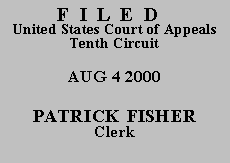

| UNITED STATES OF AMERICA,
v.
LARRY M. JENSEN |
No. 00-4024
(D.C. No. 96-CV-335-S) (D. Utah) |
Although Jensen filed his § 2255 petition in the district court before the Antiterrorism and Effective Death Penalty Act of 1996 (AEDPA) took effect on April 24, 1996, his appeal postdates AEDPA. In Slack v. McDaniel, 120 S.Ct. 1595 (2000), the Supreme Court held that a petitioner in a state habeas proceeding under 28 U.S.C. § 2254 must now obtain a certificate of appealability (COA) if his appeal is filed after AEDPA's effective date, despite the fact that the petition was filed in district court prior to AEDPA. See Slack, 120 S.Ct. at 1600. Although Slack concerned a § 2254 petition, not a § 2255 petition, the rule it announced is equally applicable to § 2255 petitions. See United States v. Glover, 2000 WL 743675, at **3 (June 9, 2000) (unpublished disposition) (stating that in Slack, the Court construed AEDPA's § 2253 COA requirement, which applies to both §§ 2255 and 2254 proceedings, in general terms, and thus applying the rule from Slack to a § 2255 petition). Therefore, Jensen must obtain a COA. Although the district court did not act on the issue of a COA, the COA is deemed denied pursuant to the General Order of October 1, 1996. See Tenth Circuit Emergency General Order issued October 1, 1996. Pursuant to Rule 22(b) of the Federal Rules of Appellate Procedure, Jensen's notice of appeal is deemed an application to this court for a COA.
On appeal, Jensen maintains that he was denied effective assistance of counsel at trial because his attorney failed to require the government to prove that L-ephedrine, which produces D-methamphetamine,(2) was the precursor chemical being purchased and used by Jensen.(3) On this issue, the magistrate judge issued a report and recommendation that an evidentiary hearing be held to determine the type of methamphetamine involved in Jensen's offense. (See Magistrate Report and Recommendation of March 2, 1998, at 11.) The district court, however, determined that no evidentiary hearing was necessary because sufficient evidence existed in the record showing that L-ephedrine was the precursor chemical purchased and used by Jensen in manufacturing the methamphetamine. See Jensen v. United States, No. 2:96-CV-0335-S, slip op. (D. Utah Dec. 22, 1999). Because L-ephedrine produces D-methamphetamine, no hearing was necessary to determine that the methamphetamine Jensen intend to produce was D-methamphetamine.
Our review of the record shows no error in the district court's conclusion. There was sufficient evidence to show that L-ephedrine was the chemical being purchased and used. (See Jensen Affidavit, Aple. Br., Attachment B (referring to "elephedrine"); Objection to Pre-Sentence Report, at 3 n.1. ("The continued reference to ephedrine is incorrect, and should be elephedrine."); Report of William Epstein, Aple. Br., Attachment F (stating that L-ephedrine is discussed on the audiotapes obtained from the DEA).) Therefore, even if Jensen could show that his counsel was constitutionally deficient in not challenging the sentence calculation based on D-methamphetamine, he cannot show that he suffered the requisite prejudice under Strickland v. Washington, 466 U.S. 668, 104 S.Ct. 2052, 80 L.Ed.2d 674 (1984). Because the record contains sufficient evidence to address Jensen's claim, there was no error in not holding an evidentiary hearing on the issue.
Jensen also argues on appeal that the district court judge's ruling was biased and prejudicial towards him. We find the argument of judicial bias to be without merit. Contrary to Jensen's arguments, the district court ruling was consistent with Tenth Circuit law.
Other arguments concerning failure to appoint counsel and a departure under U.S.S.G. §5K2.12 also lack merit. There is no constitutional or statutory right to appointment of counsel in a § 2255 proceeding when relief is denied without an evidentiary hearing. See Swazo v. Wyoming, 23 F.3d 332, 333 (10th Cir. 1994). As the magistrate judge found, the downward departure claim is procedurally barred, and Jensen has not shown cause and prejudice to overcome that bar. See United States v. Frady, 456 U.S. 152, 167-68, 102 S.Ct.1584, 1594, 71 L.Ed.2d 816 (1982).
Jensen's application for a COA is DENIED, and the appeal is DISMISSED. His motion to proceed in forma pauperis is GRANTED.
ENTERED FOR THE COURT
David M. Ebel
Circuit Judge
*.After examining appellant's brief and the appellate record, this panel has determined unanimously that oral argument would not materially assist the determination of this appeal. See Fed. R. App. P. 34(a)(2) and 10th Cir. R. 34.1(G). The case is therefore ordered submitted without oral argument. This Order and Judgment is not binding precedent, except under the doctrines of law of the case, res judicata, and collateral estoppel. The court generally disfavors the citation of orders and judgments; nevertheless, an order and judgment may be cited under the terms and conditions of 10th Cir. R. 36.3.
1.Amendment 468 adds an application note to U.S.S.G. §2D1.1 authorizing downward departures in cases involving reverse sting operations. See U.S.S.G. §2D1.1 cmt. n. 15.
2.The drug methamphetamine exists in two forms, L-methamphetamine and D-methamphetamine. L-methamphetamine, which is produced from D-ephedrine, has little or no physiological effect when ingested. D-methamphetamine, which, as noted above, is produced from L-ephedrine, produces the high sought by the drug's users. See United States v. Gillis, 114 F.3d 1198, at **1, 3 (10th Cir. 1997) (unpublished disposition).
3.At the time of Jensen's sentence, the Sentencing Guidelines treated manufacture of L-methamphetamine much less severely than manufacture of D-methamphetamine. See e.g., United States v. Dudden, 65 F.3d 1461, 1470 (9th Cir. 1995).